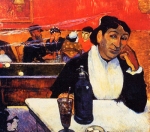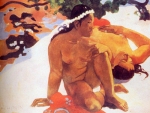Quei giovani artisti, che il mondo conoscerà in quanto protagonisti delle avanguardie russe - da Michail Larionov a Natalia Goncharova, da Kandinskij a Malevich, da Petrov-Vodkin a Maskov, Kuprin, Lentulov - frequentavano, infatti, negli anni della formazione, le collezioni di tre straordinari personaggi della Mosca di fine secolo: Michail e Ivan Morozov e Serghej Schukin.
 Nelle loro case trovavano raccolti Manet, Monet e Renoir, Cezanne, van Gogh e Gauguin, Derain, Matisse. Michail Morozov, carattere eccentrico e singolare, fu il primo, in Russia, a scoprire l'opera del tardo Gauguin.
Nelle loro case trovavano raccolti Manet, Monet e Renoir, Cezanne, van Gogh e Gauguin, Derain, Matisse. Michail Morozov, carattere eccentrico e singolare, fu il primo, in Russia, a scoprire l'opera del tardo Gauguin.
Subito dopo, ma senza che i due collezionisti fossero tra loro in contatto, anche Serghej Schukin cominciò ad acquistare quadri dell'artista francese. «Costoro,» scrive Albert Kostenevich nel catalogo della mostra dedicata a Paul Gauguin e l'avanguardia russa (Ferrara, Palazzo dei Diamanti, fino al 2 luglio 1995; catalogo Artificio, Firenze), «ebbero il grande merito di riconoscere il talento di Gauguin quando l'artista era ancora in vita e quando non ci si arrischiava, in Francia o altrove, a comprare opere così alternative rispetto ai canoni estetici vigenti nella società europea di fine Ottocento.»
La mostra Paul Gauguin e l'avanguardia russa racconta, per la prima volta nel mondo, questa storia. Presenta, per la prima volta in Italia, queste tre figure, destinate a occupare un luogo privilegiato nella storia del collezionismo d'arte. La rassegna espone tredici dipinti di Gauguin: un prestito eccezionale, concesso al Palazzo dei Diamanti di Ferrara dai musei eredi delle grandi collezioni.
 Sei provengono dalla raccolta Morozov; sette dalla casa di Serghej Shukin. Serghej Shukin, quasi preparando gli artisti russi ad ascoltare la lezione del francese nel modo giusto, aveva disposto i suoi sedici Gauguin, nella sala da pranzo della sua casa, «talmente stretti l'uno all'altro da non riuscire a capire dove finisca uno e dove cominci l'altro». Le tele formavano così un'insolita iconostasi, l'affollata raccolta di icone sacre tipica delle chiese bizantine e russe.
Sei provengono dalla raccolta Morozov; sette dalla casa di Serghej Shukin. Serghej Shukin, quasi preparando gli artisti russi ad ascoltare la lezione del francese nel modo giusto, aveva disposto i suoi sedici Gauguin, nella sala da pranzo della sua casa, «talmente stretti l'uno all'altro da non riuscire a capire dove finisca uno e dove cominci l'altro». Le tele formavano così un'insolita iconostasi, l'affollata raccolta di icone sacre tipica delle chiese bizantine e russe.
Dal Caffè ad Arles del 1888, ai Girasoli del 1901, passando attraverso alcune delle opere più amate e conosciute del pittore - nato a Parigi nel 1848 - la mostra consente di accompagnarlo nell'ultimo febbrile decennio di vita e di lavoro, trascorso tra Tahiti e le Isole Marchesi. Il Caffè ad Arles è un'opera importante, che risale agli anni della ricerca della sintesi, degli studi con Emile Bernard, della Bretagna e di Arles, dove Gauguin - seppure per pochi mesi - aveva vissuto accanto a van Gogh. Il dipinto con I fiori di Francia, invece, è considerato uno dei primi lavori eseguiti a Tahiti.
 Quando sbarcò a Papeete, «con un gran cappello di feltro sui capelli lunghi alle spalle e con un fucile Winchester ad armacollo», come scrive, ancora in catalogo, Maria Grazia Messina, Gauguin sapeva benissimo che cosa voleva. Sapeva che cosa avrebbe trovato. «Parto per starmene tranquillo,» scriveva, «libero dalla civiltà. Voglio fare dell'arte semplice, per questo ho bisogno di ritemprare le mie forze a contatto con la natura ancora vergine, di vedere solo selvaggi e vivere la loro vita senza altra preoccupazione che tradurre con la semplicità di un bambino le fantasie della mente.»
Quando sbarcò a Papeete, «con un gran cappello di feltro sui capelli lunghi alle spalle e con un fucile Winchester ad armacollo», come scrive, ancora in catalogo, Maria Grazia Messina, Gauguin sapeva benissimo che cosa voleva. Sapeva che cosa avrebbe trovato. «Parto per starmene tranquillo,» scriveva, «libero dalla civiltà. Voglio fare dell'arte semplice, per questo ho bisogno di ritemprare le mie forze a contatto con la natura ancora vergine, di vedere solo selvaggi e vivere la loro vita senza altra preoccupazione che tradurre con la semplicità di un bambino le fantasie della mente.»
Tutto questo è vero solo in parte. Lo stile che Gauguin raggiunse in Polinesia, quella sintesi personalissima di influenze e maniere diverse, si era già formato in Europa. In Polinesia, Gauguin - rinato «selvaggio», «lupo senza collare» - ebbe tuttavia il coraggio di trarne le ultime conseguenze, esaltandone, al contatto con una natura e una popolazione completamente nuove, ogni potenzialità. Non si dimenticò mai dell'Europa, dell'arte greca e di Manet, degli incisori tedeschi del Cinquecento; non dimenticò mai le amatissime stampe giapponesi.
 Dietro la figura in primo piano di Come! Sei gelosa?, opera che - apparentemente - ritrae dal vivo due donne tahitiane sulla spiaggia, si cela il ricordo di una statua greca. Il viaggio a ritroso nello spazio e nel tempo che Gauguin potè compiere in Oceania, non lo portò affatto a dimenticare l'Europa. Né, in realtà, a soddisfare la sua esigenza di "primitivo" e di "selvaggio". I "primitivi", nel mondo, cominciavano a scomparire. Tahiti, anche se non era ancora affollata di turisti e coppiette in viaggio di nozze, era già piena di biciclette.
Dietro la figura in primo piano di Come! Sei gelosa?, opera che - apparentemente - ritrae dal vivo due donne tahitiane sulla spiaggia, si cela il ricordo di una statua greca. Il viaggio a ritroso nello spazio e nel tempo che Gauguin potè compiere in Oceania, non lo portò affatto a dimenticare l'Europa. Né, in realtà, a soddisfare la sua esigenza di "primitivo" e di "selvaggio". I "primitivi", nel mondo, cominciavano a scomparire. Tahiti, anche se non era ancora affollata di turisti e coppiette in viaggio di nozze, era già piena di biciclette.
Cominciava, invece, l'era del "primitivo" nell'arte. E nel segno della riscoperta del primitivo potè compiersi e avverarsi la disperata profezia contenuta nell'ultima lettera di Gauguin. La seconda parte della mostra di Ferrara, dedicata ai pittori dell'avanguardia russa, spiega - con l'immediata forza di confronti chiari e comprensibili - quali possano essere le conseguenze delle migrazioni che - sempre, fin dalle epoche più remote - hanno seguito le vicende dell'arte.
La storia che la mostra racconta è, in questo senso, esemplare. Questa, davvero, è la libertà dell'arte.




